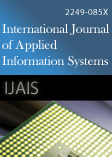
- Elie Tagne Fute and Emmanuel Tonye 2013. Modelling and Self-organizing in Mobile Wireless Sensor Networks: Application to Fire Detection. International Journal of Applied Information Systems. 5, 3 (February 2013), 1-7. DOI=http://dx.doi.org/10.5120/ijais450874
-
@article{10.5120/ijais2017451568, author = {Elie Tagne Fute and Emmanuel Tonye}, title = {Modelling and Self-organizing in Mobile Wireless Sensor Networks: Application to Fire Detection}, journal = {International Journal of Applied Information Systems}, issue_date = {February 2013}, volume = {5}, number = {}, month = {February}, year = {2013}, issn = {}, pages = {1-7}, numpages = {}, url = {/archives/volume5/number3/423-0874}, doi = { 10.5120/ijais12-450874}, publisher = { xA9 2012 by IJAIS Journal}, address = {} } -
%1 450874 %A Elie Tagne Fute %A Emmanuel Tonye %T Modelling and Self-organizing in Mobile Wireless Sensor Networks: Application to Fire Detection %J International Journal of Applied Information Systems %@ %V 5 %N %P 1-7 %D 2013 %I xA9 2012 by IJAIS Journal
Abstract
A program to enable optimal alignments searching between two sequences, the host sequence (normal plant) and query sequence (Virus). Looking for homologues has become a routine operation of biological sequences in 4X4 combination with different subsequence (word size). The program takes advantage of the high degree of homology between such sequences to construct an alignment of the matching regions. The main aim is to detect the overlapping reading frames. This program also enable to find out the highly infected colones selection highest matching region with minimum gap or mismatch zones and unique virus colones matches. This is a small, portable, interactive, front-end program intended to be used to find out the regions of matching between host sequence and query subsequences. All the operations are carried out in fraction of seconds, depending on the required task and on the sequence length.
References
- S. Byungrak, Yong sork Her, and K. Jung-Gyu. A Design and Implementation of Forest-Fires Surveillance System based onWireless Sensor Networks for South Korea Mountains. In IJCSNS International Journal of Computer Science and Network Security, Vol. 6 No. 9B, 2006.
- Y. Chevaleyre. Theoretical Analysis of the Multi-Agent Patrolling Problem. In IAT, 2004.
- D. M. Doolin and N. Sitar. Wireless sensors for wildfire monitoring. In Proceedings of the SPIE, Vol. 5765, pages 477–484, 2005.
- Chien-Liang Fok. Efficient Fire Detection and Tracking Using Mobile Agents in a Wireless Sensor Network. In MURI ONR 3-Year Review, Baltimore, 2004.
- E. T. Fute, F. Lauri, A. Koukam, and E. Tonye. The Coverage Problem in Wireless Sensor Networks by Holonic Multi-agent Approach. In International Journal of Computing and ICT Research, IJCIR, ACM, ISSN 1818-1139 (Print), ISSN 1996-1065 (Online), Vol. 3, No. 1, pages 32– 41, 2009.
- E. T. Fute, E. Tonye, A. Koukam, and F. Lauri. Multi-Agent Patrolling Strategy: Application to the Exploration Environment Problem. In International Journal of Automation, Robotics and Autonomous Systems, ICGST-ARAS, ISSN 1687-4811 (Print), 1687-482X (Online), Vol. 9, Issue 2, 2009.
- A. Nicolas Gaud. Systmes Multi-Agents Holoniques : De L'analyse L'implantation. PhD thesis, Universit de Technologie de Belfort-Montbliard, 2007.
- Arnaud Glad. Etude de l'auto-organisation dans les algorithmes de patrouille multi-agent fondes sur les phromones digitales. PhD thesis, Universit Nancy 2, 2011.
- F. Lauri and A. Koukam. A Two-Step Evolutionary and ACO Approach for Solving the Multi-Agent Patrolling Problem. In WCCI, Hong-Kong, China, 2008.
- Z. Li, S. Nadon, and J. Cihlar. Satellite detection of Canadian boreal forest fires: development and application of the algorithm. In International Journal of Remote Sensing, Vol. 21, no. 16, pages 3057–3069, 2000.
- A. Machado, G. Ramalho, J. D. Zucker, and A. Drogoul. Multi-Agent Patrolling : an Empirical Analysis of Alternatives Architectures. In Proc. of 3rd MABS, pages 155–170, 2002.
- D. Massaguer. Multi Mobile Agent Deployment on Wireless Sensor Networks. In University of California, Irvine, 2005.
- C. Massimo, Gaud Nicolas, S. Galland, V. Hilaire, and A. Koukam. A Holonic Metamodel for Agent-Oriented Analysis and Design. In Industrial Applications of Holonic and Multi-Agent Systems: Holonic and Multi-Agent Systems for Manufacturing, pages 237–246, 2007.
- MODIS. Moderate-resolution Imaging Spectroradiometer. In MODIS, 2008. http://modis. gsfc. nasa. gov/index. php, visited the 02 july 2008.
- S. Rodriguez, V. Hilaire, and al. A Formal Holonic Framework with Proved Self-Organizing Capabilities. In World Scientific, 2007.
- S. Rodriguez, V. Hilaire, and A. Koukam. Toward a Methodological Framework for Holonic multi-agent systems. In ESAW'03, 2003.
- Liyang Yu, Neng Wang, and Xiaoqiao Meng. Real-time Forest Fire Detection with Wireless Sensor Networks, IEEE. In proc IEEE MABS, 2005.
Keywords
Wireless sensor network, mobile sensors, patrolling, agent,
 10.5120/ijais12-450874
10.5120/ijais12-450874
